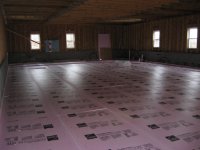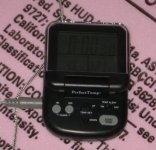jdmar
Gold Member
Yes, I took the risk...I poured concrete last thursday in northeast ohio...brrr. It got cold that night (17 degrees to be exact).
The concrete was poured in a semi sealed building. It was poured on R-10 reflective foil/foam on gravel with poly underneath. It has wire mesh/WWR and radiant tubing (not yet with heat in them too bad huh!?). It was 6 1/2 sack made with heated water. It was SUPPOSED to have accelerators in it (the guy who ran the pump said no but the mix delivery guy said yes)...I think it did have the accelerator. It also has fiber in it. As soon as I could safely do (the next am...about 8-10 hours after final finish) I covered with R-10 foam on top. Therefore it was then in a full R-10 "package/envelope." About 12-24 hours after it was poured the temp on the top was 37-41 degrees F. Some spots near the garage door and wind side were 35 degrees. So it got cold enough to stop hydrating (below 40)but not so cold it frooze. No surface measures were freezing. After covering and attempting to heat the building the temp did climb...in fact it hit 56 degrees F on the slab surface in spots. 8 days later I still got surface temps of 41 to 48 degrees in various spots. The slab is 4-5 inches thick.
Now, for my question. When I lift the foam insulation board it is mildly damp on the surface...not standing water. Think condensation/dew amount of water. Should I now remove the foam and let the concrete dry more or should I leave the foam on as long as possible. My thoughts are as follows but I need smarter advice than my guesses.
1. Leaving the foam would keep it warmer longer and therefore help it hydrate and harden as much as possible. But if/when it does start to freeze...will the higher moisture put the slab or surface at higher risk of cracks or surface popping? But since there is good insulation it may stay warm (i.e above 40 degreesF) for a looong time since it is getting ground warmth. Not sure what wins out here. I think my heat generated but the hydration process is probabble minimal now (10 days after pour).
2. Removing the foam now would likely slow the final cure (but it is likely hard enough to survive the winter now). But it would also allow evaporation of moisture and in theory decrease the risk of cracks/surface pops/chips if/when it does freeze. I know concreete likes moisture to cure...but I doubt that is such a big deal now 10 days later.
I need some opinions advice from those with experience and a lot more knowledge than me. ANd sadly yes...there are spots at the edge of the exposed slab at the garage door that I could chip a couple days ago by pushing a screwdriver into the edge...so you think this part will "heal" or will I just have to repour that edge (not a big deal really). Thanks for your help/advice.
Peter
The concrete was poured in a semi sealed building. It was poured on R-10 reflective foil/foam on gravel with poly underneath. It has wire mesh/WWR and radiant tubing (not yet with heat in them too bad huh!?). It was 6 1/2 sack made with heated water. It was SUPPOSED to have accelerators in it (the guy who ran the pump said no but the mix delivery guy said yes)...I think it did have the accelerator. It also has fiber in it. As soon as I could safely do (the next am...about 8-10 hours after final finish) I covered with R-10 foam on top. Therefore it was then in a full R-10 "package/envelope." About 12-24 hours after it was poured the temp on the top was 37-41 degrees F. Some spots near the garage door and wind side were 35 degrees. So it got cold enough to stop hydrating (below 40)but not so cold it frooze. No surface measures were freezing. After covering and attempting to heat the building the temp did climb...in fact it hit 56 degrees F on the slab surface in spots. 8 days later I still got surface temps of 41 to 48 degrees in various spots. The slab is 4-5 inches thick.
Now, for my question. When I lift the foam insulation board it is mildly damp on the surface...not standing water. Think condensation/dew amount of water. Should I now remove the foam and let the concrete dry more or should I leave the foam on as long as possible. My thoughts are as follows but I need smarter advice than my guesses.
1. Leaving the foam would keep it warmer longer and therefore help it hydrate and harden as much as possible. But if/when it does start to freeze...will the higher moisture put the slab or surface at higher risk of cracks or surface popping? But since there is good insulation it may stay warm (i.e above 40 degreesF) for a looong time since it is getting ground warmth. Not sure what wins out here. I think my heat generated but the hydration process is probabble minimal now (10 days after pour).
2. Removing the foam now would likely slow the final cure (but it is likely hard enough to survive the winter now). But it would also allow evaporation of moisture and in theory decrease the risk of cracks/surface pops/chips if/when it does freeze. I know concreete likes moisture to cure...but I doubt that is such a big deal now 10 days later.
I need some opinions advice from those with experience and a lot more knowledge than me. ANd sadly yes...there are spots at the edge of the exposed slab at the garage door that I could chip a couple days ago by pushing a screwdriver into the edge...so you think this part will "heal" or will I just have to repour that edge (not a big deal really). Thanks for your help/advice.
Peter

